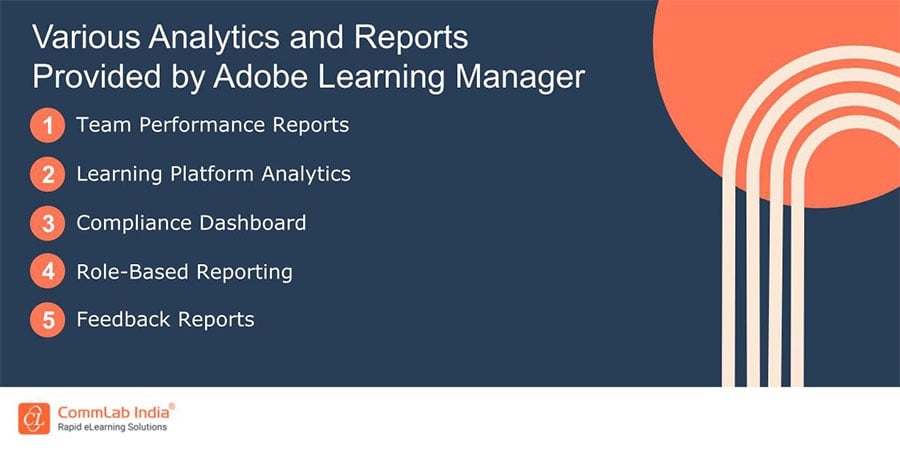How Adobe Learning Manager Delivers a Personalized Learning Experience
Adobe Learning Manager is a versatile LMS platform that can be used for a wide range of training initiatives, making it an essential tool for any organization looking to provide engaging and effective training programs to their employees, customers, or partners.

As eLearning has grown in popularity, more businesses are using learning management systems (LMS) to design, deliver, and monitor their training programs. A robust LMS platform that offers a variety of capabilities to assist organizations in developing and delivering compelling eLearning courses is Adobe Learning Manager (ALM). To further understand why Adobe Learning Manager is a crucial tool for businesses wishing to offer their employees efficient and engaging training, we’ll examine some of its primary features and use cases in this blog.
Are You Looking for a Versatile LMS? Check Out Adobe Learning Manager!
Here are a few of its notable features –
- Content Management
- Course Authoring
- Mobile Compatibility
- Social Learning
- Gamification
- Social Learning
Read on to explore its primary use cases.
To assist enterprises in managing their training and development initiatives, Adobe Learning Manager (ALM) is a powerful Learning Management System (LMS) that enables businesses to design and deliver eLearning courses, monitor employee progress, and assess learning results. The system is renowned for its user-friendly interface and intuitive design, which makes it simple to use for administrators, instructors, and learners alike.
→Download eBook Now: A Beginner’s Guide to Learning Management Systems
Features of Adobe Learning Manager
ALM offers a wide range of features that help organizations streamline their training processes and improve the effectiveness of their learning initiatives. Some of the notable features of Adobe Learning Manager include –
1. Content Management
The content management function of ALM allows users to generate and organize eLearning content within the system. Users can upload and manage a variety of multimedia components, including photographs, music, video, and text, making it simple to update and reuse content for future courses. ALM also includes a centralized content library where users can search for and reuse existing content. You also get AI-powered recommendations that will help learners decide their own learning path, which can eventually help the organizations reduce skill gaps and help learners consume training at their own pace.
2. Course Authoring
ALM’s course authoring option enables users to design and publish eLearning courses using a range of authoring tools, such as Adobe Captivate and Articulate 360. The platform also includes an authoring tool that allows users to design simple courses rapidly. Users can utilize these authoring tools to create interactive and engaging courses with an adequate number of quizzes, assessments, and multimedia elements. You can also access these eLearning authoring tools separately and integrate your courses with the LMS and other third-party applications or platforms later on.
Check out this short video to understand more about authoring tools and their basic features –
3. Mobile Compatibility
ALM is created with mobile devices in mind, making it simple for learners to access courses while they’re roaming around, for example, during their daily commutes. Because the platform is mobile-friendly, users may easily access and finish courses on their smartphones or tablets. The option to download course materials for offline viewing is another aspect of mobile compatibility. Due to the increased popularity of mobile learning, it is expected for any modern LMS to be truly compatible with mobile devices, and for that reason, ALM has its own mobile app.
4. Social Learning
ALM encourages social learning, enabling employees to cooperate and communicate with one another digitally. Online discussion forums, chat rooms, personalized feeds, and other collaborative platforms that encourage social learning and information sharing can be created by users. Social learning tools empower learners to communicate with one another and exchange information and skills. Instructors can also be a part of the practice as they can provide relevant feedback and mentorship through these platforms.
5. Gamification
Gamification is supported by ALM, enabling users to design fun and interactive learning activities. Badges, leaderboards, and awards are examples of gamification components that may be used to entice learners to finish courses. It promotes learner engagement and motivation, resulting in higher completion rates. You can decide whether you want to gamify the entire course, a part of the module, or just gamify the assessments, and then use the relevant game elements to do so. For example, you can provide engagement-based rewards to learners when they achieve certain milestones.
6. Analytics and Reporting
Administrators may track learner progress and assess the success of their training programs with the help of the extensive learning analytics and reporting capabilities provided by ALM. To obtain insights into their training programs, users may produce reports on parameters such as employee engagement, course completion rates, and other metrics. The analytics and reporting tool provides useful information that can be utilized to enhance training initiatives and pinpoint problem areas.
Use Cases of Adobe Learning Manager
Adobe Learning Manager is a versatile platform that can be used in a variety of industries and organizations. Some of the common use cases for ALM include –
1. Basic Employee Training and Professional Development
Adobe Learning Manager is an ideal tool for organizations looking to provide basic employee training. The platform’s content management, course authoring, and mobile compatibility features make it easy to create and deliver engaging training courses that employees can access from any device. Adobe Learning Manager can also be used for professional development. The platform’s social learning and gamification features encourage learners to engage with the content and each other, resulting in a more engaging and effective learning experience.
2. Customer Training
Customers or clients can receive direct training using Adobe Learning Manager. Companies may train clients how to utilize their goods or services efficiently by developing specialized eLearning courses. This may lead to better client retention, higher customer satisfaction, and lower support expenses. For instance, a particular company offers a SaaS solution, but it has a challenging learning curve. They may utilize ALM to create useful modules outlining all the key features and constraints of their product, which will aid in their consumers’ understanding of the solution.
3. Onboarding and Compliance Training
Adobe Learning Manager is an effective tool for onboarding new employees. By providing them with engaging and interactive training courses, new employees can quickly learn about the organization’s culture, policies, and procedures. Many industries have strict regulations that organizations must comply with. Adobe Learning Manager’s analytics and reporting features make it easy to track and document employee compliance training, ensuring that the organization remains compliant and avoids costly fines.
4. Partner Training
Organizations can also use Adobe Learning Manager to train their partners on products or services. In the technology sector, where businesses depend on a network of partners to market and use their goods, this kind of training is typical. Depending on the needs of the firm, partner training may involve product training, sales training, and technical training. Providing partners with the information and abilities they need to correctly and successfully represent the company’s goods and services is the aim of partner training. In order to boost sales and customer happiness, partners can benefit from customized training programs that train them how to effectively sell, install, and support goods and services.
Wrapping Up!
Adobe Learning Manager is a powerful Learning Management System that provides organizations with a comprehensive platform for managing their training and development programs. The platform offers a wide range of features, including content management, course authoring, mobile compatibility, social learning, gamification, and analytics and reporting. If you are still in a dilemma, you can check out this amazing eBook and gain more detailed insights on how to choose a perfect LMS for your organization.





